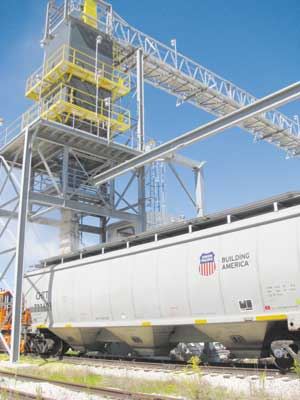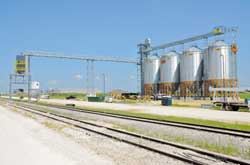|
Good Quality Milled Rice From Asia Flooding Market
Central America And Mexico Looking For Variety Specific Rough Rice
REGINA LAROSE
MidAmerica Farmer Grower
SAN JOSE, COSTA RICA
Bob Papanos of The Houston Rice Group and consultant for the U.S. Rice Producers Association urges rice producers to get back to quality. Papanos granted an interview to MidAmerica Farmer Grower at the Rice Market & Technology Convention recently in San Jose, Costa Rica. The Rice Market & Technology Convention is produced by the U.S. Rice Producers Association.
Papanos expressed concern over the Asian rice flooding the Mexico market with good quality milled rice at very low prices. “This is causing great consternation on the mills in Mexico and now in Central America.”
Papanos explained that over the past ten years Mexico bought about 90 percent rough rice and 10 percent milled rice exclusively from the United States. Now, with milled rice from the United States at about $650/ton and rice from Asia costing $450/ton, packers and distributors in Mexico are buying Vietnamese milled rice, sometimes blending it, sometimes selling it mislabeled.
“In Mexico we figure about 70 percent of the rice that is sold in Mexico, is sold on price to non-discerning consumers. They don’t care. They are not rice eaters genetically anyway, their corn eaters. So rice consumption is fairly low in Mexico. There is still about 30 percent of the market that is concerned with quality. They want very high quality rice,” he said.

Shown is rice being loaded at the rail facility at Lacassine, La.
This facility ships specific variety rice which is one way the U.S.
is meeting Mexico’s desire for specific variety rice.
The problem arose in the summer of 2010 when the rice crop was ruined by excessive heat. “We lost our reputation as providers of high quality rice. For instance, in Mexico, the company that is the most famous for high quality rice, Verde Valle in Guadalajara started buying rice from Uruguay, paying more than U.S. rice prices by the time it got there, but it was excellent quality rice, something they couldn’t get from the Mexican mills or the U.S. mills directly.”
Quality is still a problem. “Even to this day, the mills in Central America and Mexico complain that they receive the bottom of the barrel of rice that is available in the U.S. Instead of being treated as good customers, important customers, they get the crap. They get mixed varieties, with low milling yields. When they put that in their mills, it doesn’t perform well,” said Papanos.
“We’ve been trying to convince buyers in Central America and Mexico to buy variety specific, single variety, identity preserved rough rice. Some of them have started doing that and they express great amazement at how beautiful the rice is, they love it. The problem is they have to pay a little bit more. The costs of logistics are a little higher. Making sure you keep everything together and don’t dump truckloads of 14 different varieties on the same barge,” he added.
“It is U.S. number 2 rough rice. It grades, but it is impossible for any mill anywhere in the world including the U.S., to take rice from different grain lengths or grain thicknesses or shapes and sizes, and mill it all as one lot. It doesn’t work. Consumers are buying it but increasingly are complaining that it is not milled properly or tastes funny. It is not the nice little white pearls that they’re used to buying or that they can get from South America for instance,” says Papanos.

Bob Papanos of The Houston Rice Group and consultant for the U.S. Rice
Producers Association urges rice producers to get back to quality. Papanos
feels specialty rice variety may be the way for U.S. rice growers to compete.
Photo by John LaRose
According to Papanos, exports of rough rice to Central America and Mexico are down. “From a farmer’s perspective, it would disastrous if those markets abandoned U.S. origin. All that rice would be surplus and now we have a farm bill that doesn’t have any provisions for a farmer if he can’t sell his crop.”
Papanos said most all growers keep varieties of rice separate when they harvest. Once it is sold to a mill or barge loading facility the problem begins. Buyers from Central America and Mexico need to go to a seller who understands they want to buy a specific variety. “One of the buyers in Costa Rica just recently received a shipment out of Arkansas that was identity preserved. He is just amazed at the good quality of the rice and how good it will perform at the mill.”
Papanos gave an example of the U.S. meeting Mexico’s desire for specific variety rice. “The Louisiana guys have been able to do this out of a rail facility at Lacassine. They’ve shipped nothing but specific variety rice. The Louisiana Department of Agriculture financed the building of a sugar mill which is now abandoned, it didn’t work, but in that process they laid down two miles of track right on the Southern Pacific railroad main line; a beautiful rail facility. So, cobbling together police jury money, state hurricane relief money and whatever, those guys got together and formed a group and got the state to back them in building a very nice high speed rail loading setup.”
“The group proved to be successful. They sold out for the year. They got good prices. They kept prices high in South Louisiana by selling themselves, they didn’t have to sell to the mills,” he said.
Papanos believes prices in the U.S., Brazil and Argentina are not coming down. “They can’t come down. Farmers are already not making money or not making much money at current price levels. I can give you 50 examples of rice farmers who are learning how to grow other crops. One guy has 500 acres of sesame seed that he’s trying out. It is contracted, it is already sold. So, if farmers on one hand realize that they are running a business and the government is not there to support them, if they decide to put rice on a lower priority status than they have in the past, find other crops that work, Texas farmers doing cotton and getting 4-4.5 bales an acre, that is nice money. The rice industry is getting hit from two sides, your buyers don’t like the quality you’ve been shipping and the farmers don’t like the prices they’ve been getting. You’re squeezing the industry down from both sides which don’t bode well for the long term future of the rice crop in the United States.”

Papanos said most all growers keep varieties of rice separate
when they harvest. Once it is sold to a mill or barge loading
facility the problem begins. This facility at Lacassine makes
it possible to ship specific varieties.
Price competition since the signing of the CAFTA treaty played a part. “Those buyers encouraged it and people who wanted to sell to them encouraged price competition. You can be the best person in the whole world but if you’re in a price battle you start cutting corners. You blend this with that and whatever,” said Papanos.
Specific rice variety marketing improves quality. “Growers need to get back to quality. No one can predict when the surplus in Thailand will be gone, when the market can return to normal pricing; market based pricing. We’ll never beat the Asians on price. We can’t win in a price war with Asia; they’ll always be somebody trying that. You have Cambodia that’s trying to become an exporter again, Burma that is trying to become an exporter again; how do they compete, on price.”
Specialty rice variety may be the way to for U.S. rice growers to compete. “Look at what Thailand has done with aromatic rices, Jasmine, or the Indians with basmati. Basmati is the best example; it only grows in India and Pakistan in the foothills of the Himalayas. They get double the price of any other kind of rice, people gladly pay it. In the U.S. we import a lot of it because we can’t grow it here.”
Papanos addressed conventional thinking on seed research. “Without sounding critical or too much with the benefit of hindsight, all of the seed research that has been done at the state universities over the last 40-50 years has been focused solely on field yield. When you’re growing for the government, which is what rice was for many, many years, then the more pounds per acre you can harvest the more money you can make from the government. To the point that long grain rice in particular in the south is now too soft, too mushy and tasteless; it has no more redeeming qualities left to it. Those were all bred out of the parent stock; again in pursuit of higher yields. There is nothing wrong with higher yields, obviously that is the best way to make a farmer profitable. Now the farmer has to grow for the market. The market is the only thing that is going to pay them. The fact that 15-16 percent of current domestic rice consumption is imported rice and high priced imported rice, tells you that they’re not growing the varieties the market wants,” concluded Papanos. ∆
REGINA LAROSE: Associate Editor, MidAmerica Farmer Grower
|
|